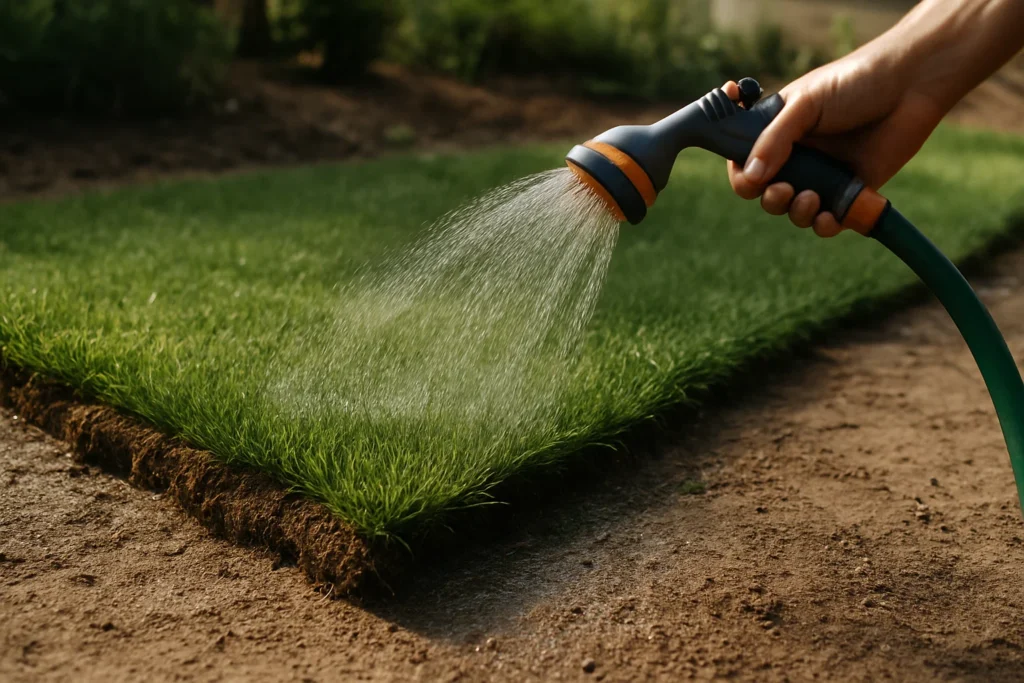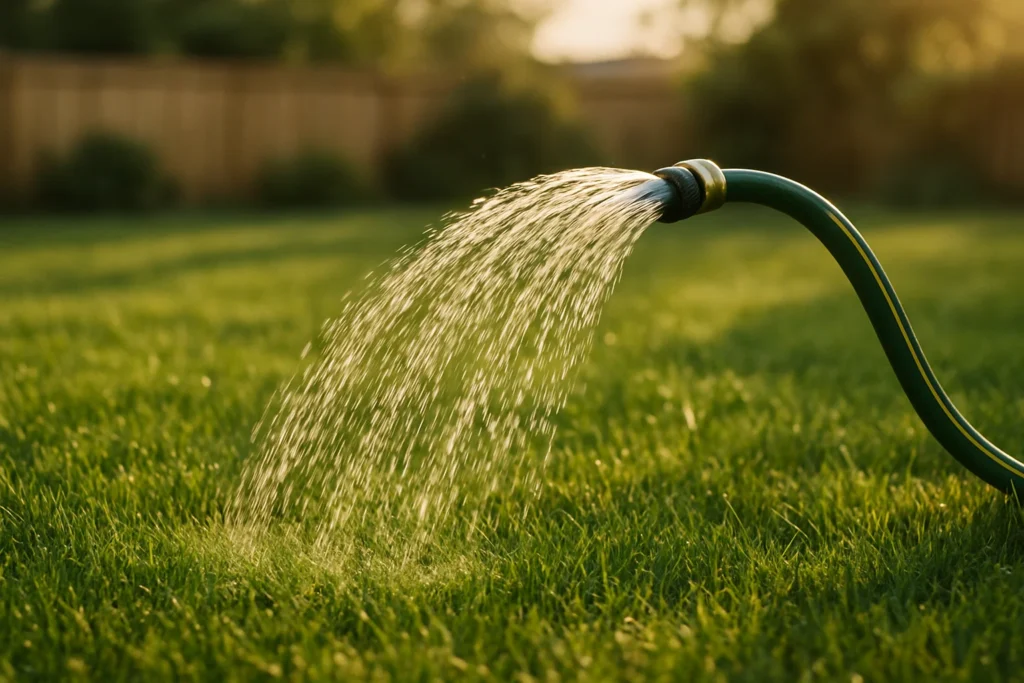When you have new sod, watering it correctly is crucial to promoting root growth. Fresh sod requires steady moisture to keep it alive and to keep the soil below it. Sod can dieback or otherwise cause problems that will impact its long-term health if it isn’t watered correctly. In this guide, you’ll find out how long and how often to water new sod, the best ways to water new sod, and hints to prevent common watering problems. Taking these easy steps also means your new lawn will reflect a beautiful and healthy look for many years in the future.
Importance of Watering New Sod
Proper watering of new sod allows the roots of the grass to penetrate to the bottom of the soil, where they can hold on tight. A sod can go brown and fail to take root if it doesn’t get enough moisture. And of course, the opposite of dry soil is soggy soil, which can cause root rot and a host of fungal issues. Soil moisture balance is critical to keep a lawn healthy.
Key Factors for Watering New Sod
- Soil (sandy soil will drain more quickly – plants will need to be watered more often).
- Weather (hot, dry conditions require more water).
- Sod thickness and root development stage.
New sod is basically grass and dirt laid on your lawn or tarmac. Its roots are shallow, and to stay damp and begin growing into the ground, it requires frequent water. Good watering service helps the sod to knit with the soil underneath, so that it does not dry or die. It also promotes strong root growth, giving way to a more resistant lawn.
How to Water New Sod
Watering new sod properly is important for it to grow healthy roots and become a lush lawn. Follow these simple tips on how to water new sod so your lawn grows green and strong:
Water Immediately After Installation
Immediately after you lay the sod, water it deeply to saturate the soil below. This first watering should soak the ground to a depth of 3 to 4 inches (how long will that take? Usually about 45 minutes, depending on your watering system). This deep soak promotes sod and soil bonding and gets you off to a quick start with root production.
Keep the Sod Moist For the First Two Weeks

Fresh sod must be watered regularly to keep it from drying out. For the first two weeks after installation, water the sod 3 to 4 times a day for 15 to 20 minutes at a time. You want the top few inches of the soil to stay consistently moist but not waterlogged.
Water Early in the Day
The ideal time to water is early morning. This cuts down on evaporation and allows the grass blades to dry a bit in the daytime, lessening the damage done by fungal diseases.
Gradually Reduce Frequency After Two Weeks
After about two weeks, you can try tapering gradually. Decrease watering frequency to 1-2 times/day, for 30-45 minutes/time, once the sod has taken root (anywhere from 10-20 days). This promotes deeper root growth into the soil.
Return to Typical Lawn Watering Schedule
Once the sod is rooted (approximately 3-4 weeks after installation), water the sod deeply, most likely between 2-3 times per week.
Avoid Overwatering
Look for clues like standing water or marshy soil, which indicate overwatering. Overwatering can smother roots and encourage disease.
With this process, you’ll be giving your sod the moisture necessary to flourish and a long life for your beautiful new lawn.
Best Methods for Watering New Sod
When it comes to watering new sod, the watering method that you use can have a huge impact on how your new lawn takes root. Fresh sod typically needs approximately 1 to 1.5 inches of water each day for the first 2 weeks, before tapering off as roots become established.
Top Tools for Watering New Sod
- Adjustable head sprinkler system for even watering.
- Soaker hoses for deep watering over a long period.
- Rain gauges can be used to observe the application of water.
Sprinkler System for Even Coverage: Sprinklers distribute the water over larger areas, and the amount of water can be adjusted.. Depending on the lawn space and shape, many people use one of three styles of sprinklers-oscillating, rotary, or impact.
Soaker Hoses for Deep Watering: Soaker hoses slowly discharge water right at soil level to prevent water loss through evaporation and runoff. This is a good way for small and medium lawns, or areas of the sod very tenderly into the watering. Soaker hoses provide deep watering without creating a soggy sod surface.
Manual Watering by Hose and Spray Nozzle: A garden hose equipped with an adjustable spray nozzle offers maximum control and is suitable for smaller patches or spot watering. You can also target areas that may dry out more quickly or could use a little extra attention, such as edges or shaded spots.
Drip Irrigation for Water and Energy Saving: Drip irrigation systems are more typically used with gardens, but can also be modified for watering sod in some instances. Drip emitters provide water at a slower rate and directly to the soil, helping to reduce water waste and encouraging deep root growth. It is said to be a very effective method, but it requires a great deal of setting up.
Rainwater Harvesting to Supplement Watering: If you live in enough precipitation, using natural water with rainwater collection systems or just rainwater alone can be used as a supplement to watering. Rainwater collected in barrels and used to water new sod is a green alternative.
Hand Bucketing for Small Areas: Water in very small sections or for spot treatments. A bucket is fine for watering new sod. It is labor-intensive, but it is also a precise way to control the amount of water and where the water goes, and you are less likely to overwater.
Smart Irrigation Systems for Precise Water Management: These characteristics make them adequate to use for controlling and monitoring of remote assets, also from the former GPRS point of view.
It employs weather information and soil moisture sensors to adjust watering schedules on its own. They are efficient because they apply only water that is necessary based on current conditions, which is a good thing for new sod that doesn’t want under- or overwatering.
How Long to Water New Sod
- Right after planting: Water for at least 45 minutes to moisten the soil.
- Daily Schedule: Begin watering in the early morning and afternoon during the first two weeks to keep the soil moist, but not wet. Tailor based on temperature and precipitation.
- Weeks one and two: Water 2-4 times each day for 15-20 minutes, maintaining consistent moisture in the soil.
- Weeks 3-4: Lower the time of daily waterings, now 1-2 times per day, but water longer each time instead (30 to 45 minutes) to promote good deep root growth.
- Move to a normal lawn watering schedule.
Schedule for Different Seasons
- Summer: Continue to water more (up to 4 times per day) because more water will evaporate more quickly.
- Spring/Fall: Average water times per day (2-3).
- Winter: Water requirements are reduced; concentrate on monitoring soil moisture.
Watering Schedule for New Sod
| Timeframe | Frequency | Duration per Session | Notes |
| Immediately after installation | 1 session | 45 minutes | Deep soak to start rooting |
| Weeks 1-2 | 2-4 times daily | 15-20 minutes | Keep the soil surface moist |
| Weeks 3-4 | 1-2 times daily | 30-45 minutes | Encourage deep root growth |
| After 4 weeks | 3 times per week | 30-60 minutes | Regular lawn watering |
Watering Tips for a Healthy Law

Use Tools to Keep it Smart and Simple
Upgrade with the purchase of a rain gauge or a soil probe to monitor levels of moisture-you need not water when your lawn is already doing great. Smart irrigation systems using moisture sensors can enable automation of the watering process, which saves both water and financially. And not forgetting that all lawn is different-adapt watering to your game and your soil.
Mow Tall and Let Clippings Stay
High grass covers the ground, therefore preventing moisture loss and making the roots long. Removal of clippings is comparable to natural mulch that preserves water and brings back minerals to the earth. Short, stripped lawns dry out faster and need more water, so keep your clippers set a little higher.
Go Green with Rainwater
Harvest rainwater, and use that to irrigate your lawn. It is free, natural, and very environmentally friendly! All you need to do is remember that this is just a supplement, not a complete replacemen,t to keep your grass healthy.
Don’t Flood Your Lawn
Water a little at a time; too rapid watering results in runoff, which is a waste of water, and can leave dry areas. In case you find puddles or wet areas, reduce the amount of time you spend watering your lawn, and perhaps aerate it to increase drainage.
Conclusion
Properly watering new sod is critical for growing a new, lush lawn. With a pattern that transitions from deep soaking upon initial installation, to shallow and frequent-ish watering, to less frequent and (once again) deep soaking, properly watering your sod will allow the roots to settle in and your lawn to flourish. Dial back and forth with watering by plan and weather/soil conditions, using the tools you need to keep an even moisture level. With proper maintenance, your newly seeded sod will become a lush, healthy lawn.
FAQ’s
Water 15-20 minutes twice a week to start off, and as roots establish, increase to 30-45 minutes.
Water 2 to 4 times a day for the first couple of weeks, then 1 to 2 times a day for the next few weeks.
Yes. Overwatering will result in soggy soil and root rot. Check for stagnant water, and less watering if necessary.
When the roots have started growing and it has rooted itself in the soil, you can resume a normal lawn watering schedule in a matter of about 3-4 weeks.
It’s best to water early in the morning so less water is lost to evaporation and you have less risk of damaging mold and fungus forming.



